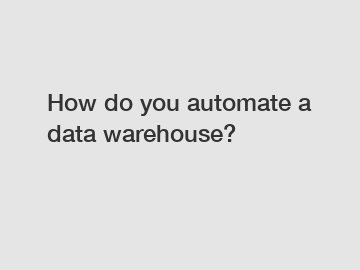How do you automate a data warehouse?
In today's data-driven era, businesses rely heavily on data warehouses to gather, analyze, and extract insights from vast amounts of information. As the volume and complexity of data continue to grow, it becomes increasingly vital to automate the processes involved in managing a data warehouse efficiently. This article aims to guide you through the best practices and strategies for automating a data warehouse successfully.
1. Understanding the Need for Automation.
Managing a data warehouse manually can be a daunting and time-consuming task. Automating key processes not only saves valuable time but also reduces the risk of human errors, enhances productivity, and ensures consistent and accurate data. By automating routine tasks, data professionals can focus on higher-value activities like data analysis and decision-making.

2. Designing the Automation Framework.
A successful automation strategy begins with a well-designed framework. Consider the following factors:
a. Scalability: Ensure that the automation framework can handle the increasing volume of data. It should be capable of accommodating future growth and expansion.
b. Flexibility: Data warehouse automation should be adaptable to changing business requirements and technological advancements. It should also integrate seamlessly with existing tools and systems.
c. Robustness: The automation framework should be reliable and resilient. It should be equipped with error handling mechanisms and appropriate monitoring tools to ensure continuous operation.
3. Selecting the Right Automation Tools.
Choosing the most suitable automation tools is crucial for achieving efficient data warehouse management. Consider tools that offer a range of automation capabilities, including ETL (extract, transform, load), data integration, and scheduling functionalities. Some popular options include Apache Airflow, Azure Data Factory, and AWS Glue.
4. Building a Future-Proof Data Model.
A well-structured, scalable, and future-proof data model serves as the foundation for an automated data warehouse. Adopting a dimensional modeling approach, such as the Kimball methodology, provides flexibility and ease of maintenance. This prevents the need for major redesigns when new data sources or analytics requirements emerge.
5. Automating ETL Processes.
Extracting, transforming, and loading (ETL) processes form the backbone of data warehouse automation. By automating ETL workflows, you can streamline data ingestion, integration, and cleansing tasks. Utilize tools that allow for creating reusable components and workflows to minimize manual effort and improve efficiency. Consider using SQL, Python, or powerful ETL tools like Informatica or Talend.
6. Implementing Continuous Integration and Deployment.
Automation in data warehousing extends beyond mere data processing. Adopting continuous integration and deployment (CI/CD) practices helps automate version-controlled code deployment, testing, and monitoring. By implementing CI/CD pipelines, you can accelerate development cycles, improve code quality, and ensure a smooth transition from development to production environments.
7. Monitoring and Alerting for Data Quality.
Maintaining data quality is crucial for a successful data warehouse. Implement robust monitoring solutions to track data quality and ensure timely detection of any anomalies. Set up alerts and notifications to immediately address potential issues, such as data duplicates, missing values, or data drift. Consider using tools like Apache Kafka, Grafana, or DataDog to monitor and visualize data warehouse performance.
8. Leveraging Machine Learning and AI.
Integrating machine learning (ML) and artificial intelligence (AI) capabilities with your automated data warehouse brings advanced analytics and predictive capabilities to the forefront. Automating processes like anomaly detection, pattern recognition, and predictive modeling enables you to unearth actionable insights from your data efficiently.
Conclusion.
Automating a data warehouse streamlines operations, improves efficiency, and empowers businesses with accurate and timely data-driven decision-making. By following the best practices outlined in this article, you can embark on a journey to a seamlessly automated data warehouse environment. Embrace the power of automation, unleash the true potential of your data, and stay ahead in the competitive landscape of the digital era.
If you want to learn more, please visit our website Automated Multidimensional Warehouse, light duty pallet racking, light duty rack.

Comments